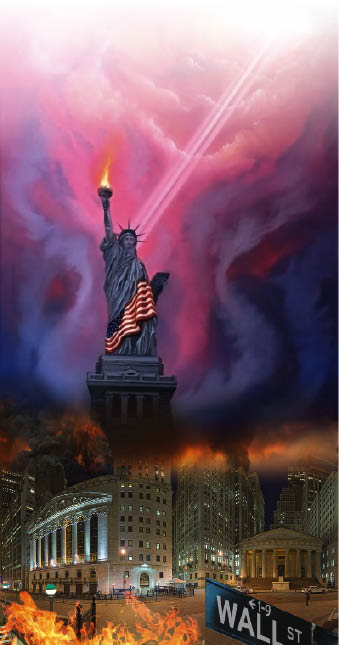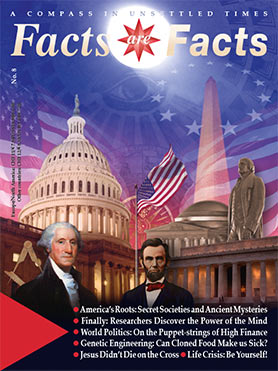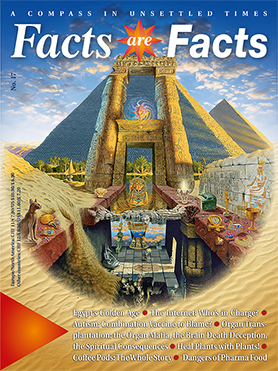Money: The End is Nigh for a Despot
If you follow the trail of money, chances are you’ll also find the true course of world history running alongside it. Read here how the power of money has darkened the path of hope with blood, sweat and tears over the last two hundred years of the Age of Pisces. Yet even if the plutocracy refuse to believe it, their days are numbered and their wealth is merely built upon the sand…
The money power preys upon the nation in times of peace & conspires against it in times of war. It is more despotic than monarchy, more insolent than autocracy, more selfish than bureaucracy.
Abraham Lincoln
When a government is dependent upon bankers for money, they and not the leaders of the government control the situation, since the hand that gives is above the hand that takes... Money has no motherland; financiers are without patriotism and without decency; their sole object is gain.
Napoleon Bonaparte
“I believe that banking institutions are more dangerous to our liberties than standing armies,” once wrote Thomas Jefferson, third president of the USA—and our modern era proves him right. “The United States can be compared with the Roman Empire directly before its fall: the financial situation is worse than reported. The state model is ruined,” said former GAO1 Comptroller General, David Walker, when in 2007 he refused to issue the audit certificate on the American budget balance due to intransparent data. If you spread the national debt evenly across the population, it works out that every single US citizen these days is about $30,000 in debt. Hour by hour the US deficit increases by 8 million dollars—not including the debts of individual federal states and communities investing in industry and private budget debt. Yet once upon a time, young America was totally debt-free –way back in 1836 when President Andrew Jackson succeeded in ending the rule of the American central bank. And so it remained until 1913; until the USA fell victim to a treacherous coup by the financial elite, who re-established a central bank—the Federal Reserve—that is the root of today’s financial misery.
 The trouble began in London in 1694, when the first central bank was established. It was called the “Bank of England”, which sounded as if it were controlled by the government. Yet that wasn’t the case then and it isn’t the case now, not at any central bank or Federal Reserve in the world.
The trouble began in London in 1694, when the first central bank was established. It was called the “Bank of England”, which sounded as if it were controlled by the government. Yet that wasn’t the case then and it isn’t the case now, not at any central bank or Federal Reserve in the world.
Christopher Hollis describes how this came about in his 1943 book The Breakdown of Money. “In 1694 the Government of William III was in sore straits for money. A company of rich men under the leadership of one William Patersonoffered to lend William £1,200,000 at 8 per cent on the condition that, the Governor and Company of the Bank of England, as they called themselves, should have the right to issue notes to the full extent of its capital. That is to say, the Bank got the right to collect £1,200,000 in gold and silver and to turn it into £2,400,000 (that is, double it), lending £1,200,000 (the gold and silver) to the Government, and using the other £1,200,000 (the banknotes) themselves. Paterson was quite right that this privilege which had been given to the Bank was a privilege to make money… In practice they did not keep a cash reserve of nearly two or three hundred thousand pounds. By 1696 (i.e. within two years) we find them circulating £1,750,000 worth of notes against a cash reserve of £36,000. That is with a ‘backing’ of only about 2 percent of what they issued and drew interest on.”
Paterson continued: “The Bank hath benefit of interest on all monies which it creates out of nothing.”
So how did the bank create money? By issuing credit, for which they printed bank notes “out of nothing.” And a profitable business it was, too: within four years the British government no longer owed the bank the initial 1.25 million pounds, but a vast 16 million—a debt explosion of 1,280 per cent.
Such a flooding of the market with new money of course leads to inflation—i.e. value per unit sinks while prices rise. This eats up the savings of the countries’ citizens, which don’t automatically increase with inflation—i.e. if depreciation is ten per cent, you’ll only be able to buy ten per cent fewer goods with the same amount of money in the bank. So what can the citizen do to deal with greater expenses? Go back to the bank and ask for new credit, which is then to be paid back with interest and compound interest. The bank simply “prints” a few more bank notes and issues the client with the sum required (today this occurs virtually, of course, without actually printing the coins or notes).
So goes the first phase of a perfidious and large-scale scheme. In the second phase, the central bank then cuts off supply. This is necessary for Phase 3 to work according to plan: the people in debt slowly go bankrupt as they no longer receive any extra money for additional growth. Now the bank can collect actual, real assets such as factories, residences or land well under value because the emerging economic crisis has pushed the prices down.
Frankfurt Beginnings
Who actually owns modern central banks is not publically known. What we do know is that they do not belong to the nation, although their names suggest otherwise. Insiders declare that one family dynasty is particularly involved in the “central bank business.” It all began in Frankfurt’s Judengasse (the city’s Jewish ghetto) when a man called Mayer Amschel Bauer decided to change his name to match the red plate above his exchange office. Since then his name has become legend: Rothschild.
Mayer Amschel Rothschild (1744-1812), the progenitor of today’s huge global dynasty gained the regard of Prince Wilhelm IX of Hessen-Hanau, then one of the richest houses in Europe, by offering him rare coins and jewellery at low prices. Rothschild also gave him a bonus for any other business the prince could send his way. And so Rothschild discovered the advantages of a line of business in which the entire dynasty would specialise for many years to come: loaning to royal houses and governments. For one thing, the sums are larger (and so is the interest on the debt) and secondly the credit is more secure because it is covered by the tax revenues of an entire nation. Rothschild lived in an extremely eventful period, in which he was determined to play a decisive part. His Illuminati Order2 founded in 1776 by Adam Weishaupt was supposed to have been very much involved in instigating the French Revolution (1789-1799). Events in the American colonies, which eventually led to the American War of Independence (1775-1783), were his concern, too. He knew that money rules the world—and that the wealthy hold the governments in their pocket.
The American War of Independence
Benjamin Franklin, one of the signatories of the Declaration of Independence, had become acquainted with the kind of business operated by the Bank of England on his visit to England in 1763. He quickly realised the dangers of having a private bank controlling the currency of a nation; until his death in 1791 he remained firmly opposed to the creation of an American central bank.
The colonies printed special bank notes, which were called Colonial Scripts. They could not be exchanged for gold or silver, yet served for monetary transactions in the developing states, which worked wonderfully in this way. It was money controlled by the colonial government, for which no one had to pay interest.
It wasn’t to remain so. In 1764, British Parliament passed the Currency Act, which forbade the American colonies to print their own money, thus forcing them to pay all future taxes to Great Britain in hard gold or silver. Benjamin Franklin later remarked: “In one year, the conditions were so reversed that the era of prosperity ended, and a depression set in, to such an extent that the streets of the Colonies were filled with unemployed.” Meaning that the new world simply lacked the money to transact the daily business, or pay people for their work. Franklin said: “The colonies would gladly have borne the little tax on tea and other matters had it not been that England took away from the colonies their money, which created unemployment and dissatisfaction. The inability of the colonists to get power to issue their own money permanently out of the hands of George III and the international bankers was the PRIME reason for the Revolutionary War.”
Money and the power of banks was thus an essential trigger for this war, too. It’s no wonder that Mayer Amschel Rothschild used his good relationship with the Prince of Hessen-Hanau to convince him to provide the British with 16,800 soldiers: preventing America’s independence was also in his interest.
When this was unsuccessful, however, the next goal of the bank elites was to control the money of the developing nation—and this was best done with a central bank. Still in 1791, the year of Benjamin Franklin’s death, Alexander Hamilton (one of the three “fathers” of the American Constitution) successfully appealed for the creation of the first American central bank, the First Bank of the United States. That same year, the bank received a twenty-year business permit.
Within the first five years, the American government borrowed an immense sum for the time—8.2 million dollars—from the US central bank, leading to a 72 per cent rise in prices in the country. Thomas Jefferson, then foreign minister of the United States, sighed: “I wish it were possible to obtain a single amendment to our Constitution […] I mean an additional article taking from the Federal Government the power of borrowing.”
In 1811, US Congress voted against a licence renewal for the American central bank. As a result, the house of Rothschild lost millions, which was said to have moved Nathan Rothschild, who in 1808 used his father’s money to open the N. M. Rothschild & Sons bank in London, to threaten: “Either the application for renewal for the charter is granted, or the United States will find itself involved in a most disastrous war.”
Just one year later in 1812, the USA and England did indeed find themselves at war: a war for which the official history books cannot give any solid valid reason. For years there had been lots of minor skirmishes between the former motherland and what were once the colonies—cited are British warship attacks against US merchant vessels, the British blockade of American harbours to prevent trade with Napoleon-occupied Europe, and other small quarrels. Some historians therefore describe this war as superfluous, unnecessary: political solutions were in fact in the offing. In the end, after four years, neither party had won and a peace treaty was signed. Nathan Rothschild’s mother (Gutle Schnaper) is said to have remarked: “If my sons did not want wars, there would be none.”
The Rothschild House Rules
On 19 September that same year (1812), the progenitor of the Rothschild dynasty passed away leaving five daughters and five sons. The two most gifted offspring, Nathan und Jacob, had in their younger days settled in Europe’s greatest metropolises—Nathan in London, Jacob, later calling himself James, in Paris. The eldest son, Amschel Mayer Jr., took over the Frankfurt business, while his brother Salomon opened a branch in the imperial city of Vienna. The least talented brother, Carl Mayer Rothschild, opened a bank in Naples. Given that these five Frankfurt men planned all business together and therefore shared the profits, much as if their five banking houses were one, they were soon nicknamed the Five Fingers.
Amschel Mayer did not only leave his sons a considerable fortune—some sources speak of 800,000 guilders, others 12 million talers (the current value of these sums is unknown)—but also a will that was to determine the house rules of the rising clan. It stated:
- All key positions in the family business must be occupied by family members.
- Only male members of the family are permitted to participate in the family business.
- The family members should marry their first and second cousins to maintain the family heritage (according to the 1905 Jewish Encyclopaedia, of the 58 Rothschild marriages existing at that time, 29 were with first cousins).
- There will be no legal inventory nor publication of the fortune made (to date Rothschild banks have never provided any concrete details of their business development or the family fortune).
- The eldest son of the eldest son is to become head of the family (if the majority of the family does not decide otherwise). This happened immediately when third-born Nathan was appointed new chief of the Rothschild house.
Sources
- 1 US Government Accountability Office
- 2 Read more here: Illuminati: A Glimpse Behind the Scenes






